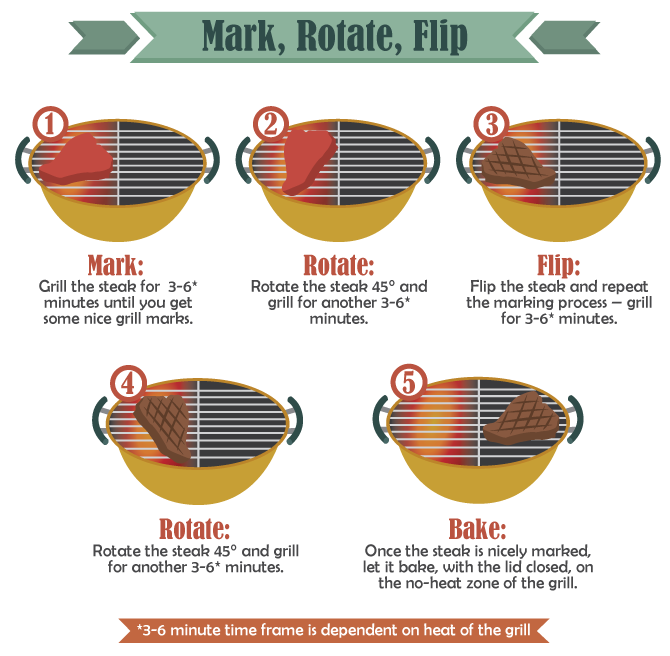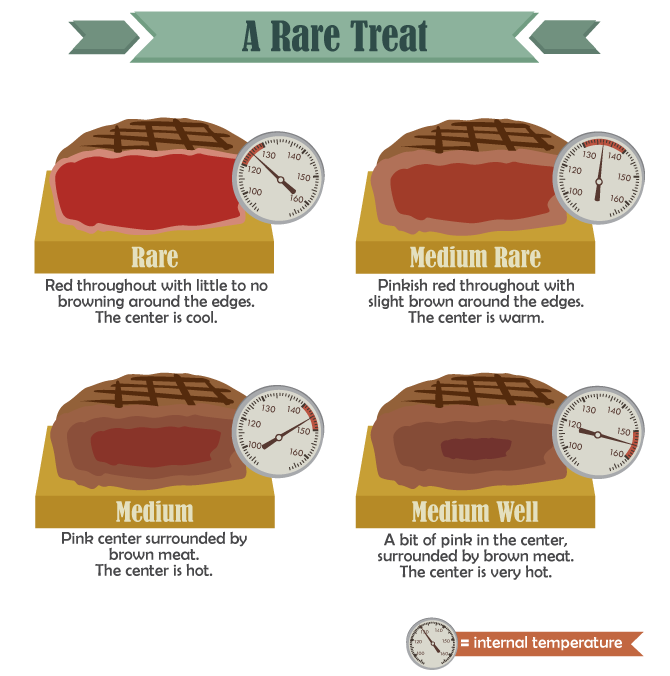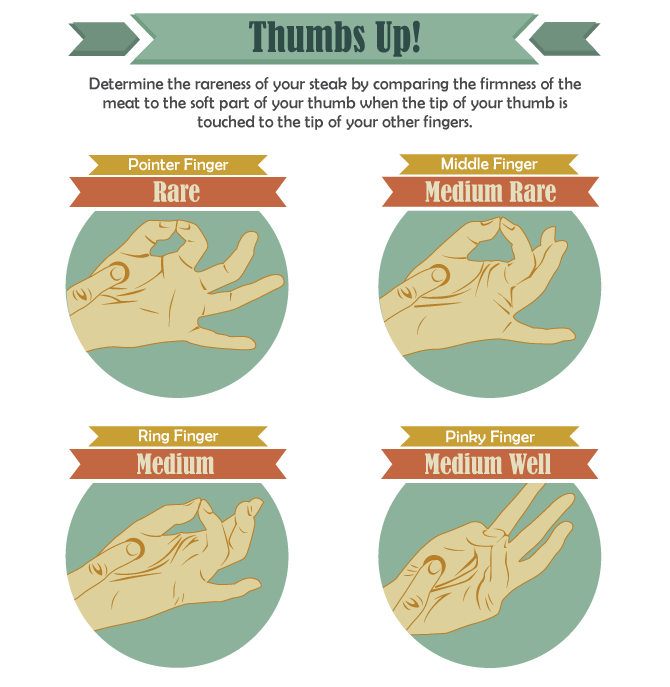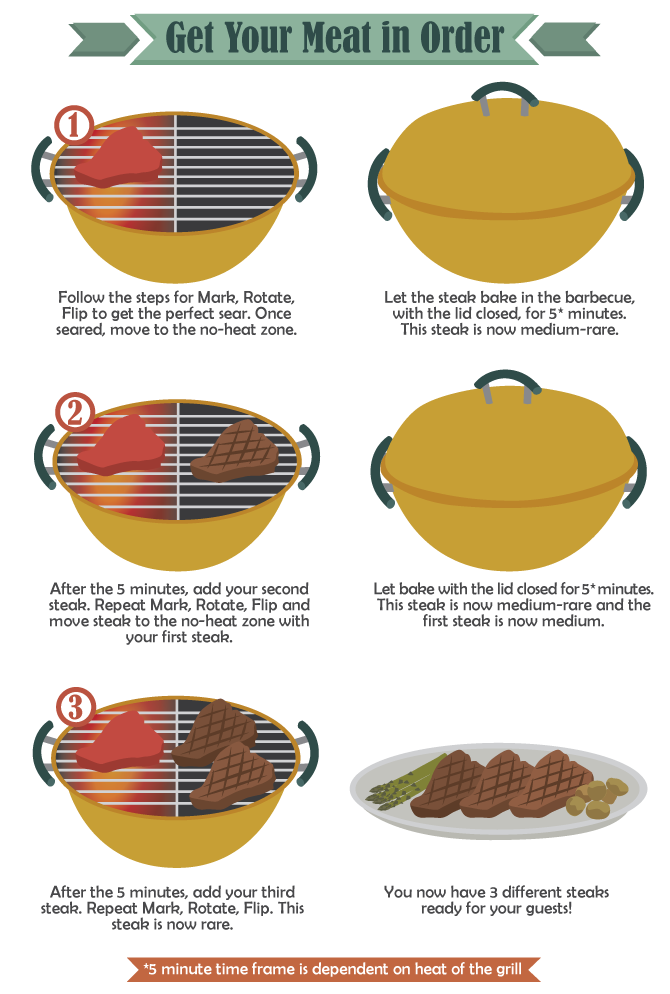Make No Mis-Steak
How to Grill Perfectly Cooked Steaks to Order – Every Time!
Grilling the perfect steak is easy. Season, sear, flip, sear, bake, rest. Grilling the perfect steak for a crowd – some of whom want their steak medium-well and others rare – is not so easy at first. With a little practice it can become pretty simple. The problem is, practicing grilling 10 different steaks at a time can be an expensive learning curve. Really expensive these days: I saw steaks go up $2 per pound in one week recently. Yikes!
So, how to practice for 10 without grilling for 10? Buy 11 steaks, practice your timing on one of them, and then use that timing for the other 10. When grilling for a crowd, I recommend you go to a local butcher and have some New York strips sliced specifically for this event. Ask for smaller steaks from farther down the primal cut in order to get the desired thickness of 1.5 inches without having steaks bigger than a dinner plate. This will save you money.
The Steaks Are High
First, remove the steak from the fridge and set it on the counter to bring it to room temperature. Second, prepare the grill for two-zone cooking with a searing hot side and no heat – other than residual – on the other side. While the grill heats up, head inside and prepare the lone steak to practice on.
The simplest seasoning involves salt, pepper, and a little oil or fat to keep the steak from sticking. I recommend grape seed oil. Begin by patting both sides of the steak with paper towel. Give it a liberal coating of coarse salt, black pepper, and pat the seasoning into the meat. Drizzle with grape seed oil and work the oil around to cover the steak’s surface entirely. Then head outside and slap that slab of meat over the hot side of the grill.
At this point a timer or stopwatch would come in handy (hint: there’s probably an app for that). Peek at the underside of the steak every 60 seconds or so until a nice row of grill marks appears. Note how long it took to get those grill marks on the timer/stopwatch. It should take three to six minutes depending on the heat of the grill. Rotate (not flip) the steak 45 degrees and allow the steak to sear for as long as it took to get the first set of grill marks. Now is the time to flip and repeat the process on the other side. Once the steak has cross-hatch grill marks on both sides, send it to the side with no heat.

Once the steak is perfectly seared, depending on the thickness, it will be somewhere between rare and medium-rare. What does that mean exactly? What is rare? What is medium-rare?
A rare steak is red throughout and the center is cool. With little to no browning around the edges, the meat has an internal temperature of 120-130 degrees, and is extremely spongy. A properly seared steak is rare if it is an inch or more in thickness. It has to be “baked” on the side of the grill with no heat to get to the next degree of doneness and beyond. Generally speaking, a 1.5-inch-thick steak on a grill that’s running 500-plus degrees will get to medium-rare from rare in around four to eight minutes. This will change with differing grill heat and steak thickness. Medium-rare steak is pinkish red throughout with slight brown around the edges. The center is warm and has an internal temperature of 130-140 degrees. A medium steak is between 140-150 degrees internally and has a pink, warm-to-hot center, with brown around the edges. It is firmer than the previous two. A medium-well steak has a hot center with a little pink surrounded by mostly browned meat and is between 150-160 degrees. Well done steak has no pink whatsoever. It’s brown all the way through, very hot and very firm to the touch.

The Thumb Test
How are you to know how rare your steak is without cutting into it? The answer lies in the firmness of the meat. To determine degree of doneness, use the thumb test. Push on the steak with the tongs to see how spongy it is. Then form the “OK” sign with one hand by touching the tip of the forefinger to the tip of the thumb. With the other hand, squeeze the meaty part of the palm below the thumb. The sponginess of this area is about the same as that of a medium-rare steak. Now touch the thumb to the tip of the middle finger and squeeze the fat part of the thumb. That’s the same consistency as medium. Then do the ring finger, which is medium-well, and the pinky is well-done.

So, with this new information in hand and your freshly seared, rare steaks moved across to the indirect zone, close the lid and let them cook further. Leave the lid closed for four to eight minutes, depending on the heat of the grill and the thickness of the steak. Test the sponginess at the four-minute mark. The steak should be firmer and fully into medium-rare range. Time exactly how long this takes with your timer/stopwatch. However many minutes took to get to medium-rare it will also take to get to medium. Note the time it took to get great grill marks and the time to “bake” the steak to take it from one level of doneness to the next. Those two numbers are vital when doing this for a crowd.
For the sake of this discussion, let’s call it five minutes for steak to go from rare to medium-rare, another five to go from medium-rare to medium, and so on. Keep in mind that this varies from one grill to the next and depends on the thickness of the steaks.
Now it’s time to grill for a crowd. Ask your guests how they want their steaks and then group them by doneness level. For illustration’s sake, let’s say three people want their steaks medium, three medium-rare, and four people want gloriously rare steaks. If your actual requests are different, you’ll have to adjust the order of things somewhat to suit your guests, but the following method will be a good guide to start with.
Season the steaks that need to be medium and slap them on the grill, searing perfectly at both angles and on both sides. Then slide them over to the side with only residual heat and close the lid for five minutes. During this time, season the three steaks to be medium-rare and slap them on the hot side, leaving the lid open while searing so you don’t continue to bake the first three steaks. After searing on both sides, slide the now rare steaks over next to the three medium-rare steaks that will soon be medium, and close the lid for five minutes. While those six are baking, season the last four steaks guests have requested to be rare. After five minutes, the first set of steaks are now medium, the second set are medium-rare, and now the last four will be seared to a perfect rare. And they are all ready to come off the grill at the same time.

Finally, let those big, perfectly grilled steaks rest. After coming off a hot grill, the juices inside are in a frenzied state, but are safely locked inside the meat. If the meat is cut open too soon, those juices have an exit and will head straight for the plate rather than guests’ taste buds. Wait four or five minutes and the juices will settle down, redistribute throughout the meat, and ensure that every bite is juicy and delicious.
Embed the article on your site

